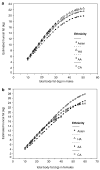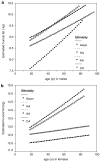Truncal fat in relation to total body fat: influences of age, sex, ethnicity and fatness
- PMID: 17452992
- PMCID: PMC2752389
- DOI: 10.1038/sj.ijo.0803624
Truncal fat in relation to total body fat: influences of age, sex, ethnicity and fatness
Abstract
Objective: To investigate the influence of age, sex, ethnicity and total fatness on central obesity in four ethnic populations.
Design: Cross-sectional analysis of study subjects enrolled from 1993 to 2005.
Subjects: A multi-ethnic (Caucasian (CA), African-American (AA), Hispanic-American (HA) and Asian (As)) convenience sample of 604 men and 1192 women (aged 18-96 years, body mass index 15.93-45.80 kg/m(2)).
Measurements: Total body fat (TBF) and truncal fat were measured by dual-energy X-ray absorptiometry. General linear regression models were used to test for independent associations with log(10)-transformed truncal fat.
Results: For all ethnicities, men had a lower percent body fat and more truncal fat than women. Log(10-)transformed truncal fat increased with TBF approximately as a square root function. At older ages, there was a greater amount of truncal fat in CA, HA and As men (approximately 0.20-0.25 kg/decade) with the effect more pronounced in AA men ( approximately 0.33 kg/decade). For women, the increment of truncal fat per decade was reduced in CA and AA women (approximately 0.07 kg) compared with As and HA women (approximately 0.33 kg). Adjusted for mean values of covariates in our sample, AA had less truncal fat than As.
Conclusion: The accumulation of truncal fat is strongly related to age, ethnicity and total fatness in both men and women.
Conflict of interest statement
Each author declared that she or he has no conflict of financial or personal interests in any company or organization sponsoring this study.
Figures


References
-
- Ogden CL, Carroll MD, Curtin LR, McDowell MA, Tabak CJ, Flegal KM. Prevalence of overweight and obesity in the United States, 1999–2004. JAMA. 2006;295:1549–1555. - PubMed
-
- Haslam DW, James WPT. Obesity. Lancet. 2005;366:1197–1209. - PubMed
-
- Folsom AR, Kushi LH, Anderson KE, Mink PJ, Olson JE, Hong CP, et al. Associations of general and abdominal obesity with multiple health outcomes in older women: the Iowa Women’s Health Study. Arch Intern Med. 2000;160:2117–2128. - PubMed
-
- Marcus MA, Murphy L, Pi-Sunyer FX, Albu JB. Insulin sensitivity and serum triglyceride level in obese white and black women: relationship to visceral and truncal subcutaneous fat. Metabolism. 1999;48:194–199. - PubMed
-
- Bergman RN, Kim SP, Catalano KJ, Hsu IR, Chiu JD, Kabir M, et al. Why visceral fat is bad: mechanisms of the metabolic syndrome. Obesity. 2006;14 (Suppl):16S–19S. - PubMed
Publication types
MeSH terms
Grants and funding
LinkOut - more resources
Full Text Sources
Medical
Research Materials

